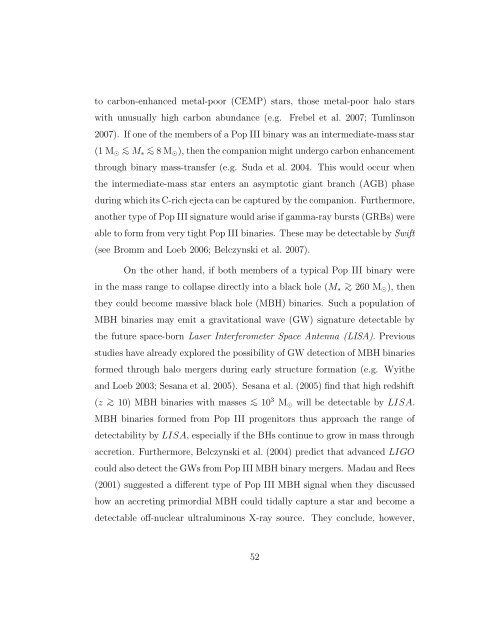Copyright by Athena Ranice Stacy 2011 - The University of Texas at ...
Copyright by Athena Ranice Stacy 2011 - The University of Texas at ...
Copyright by Athena Ranice Stacy 2011 - The University of Texas at ...
You also want an ePaper? Increase the reach of your titles
YUMPU automatically turns print PDFs into web optimized ePapers that Google loves.
to carbon-enhanced metal-poor (CEMP) stars, those metal-poor halo stars<br />
with unusually high carbon abundance (e.g. Frebel et al. 2007; Tumlinson<br />
2007). If one <strong>of</strong> the members <strong>of</strong> a Pop III binary was an intermedi<strong>at</strong>e-mass star<br />
(1 M⊙ < ∼ M∗ < ∼ 8 M⊙), then the companion might undergo carbon enhancement<br />
through binary mass-transfer (e.g. Suda et al. 2004. This would occur when<br />
the intermedi<strong>at</strong>e-mass star enters an asymptotic giant branch (AGB) phase<br />
during which its C-rich ejecta can be captured <strong>by</strong> the companion. Furthermore,<br />
another type <strong>of</strong> Pop III sign<strong>at</strong>ure would arise if gamma-ray bursts (GRBs) were<br />
able to form from very tight Pop III binaries. <strong>The</strong>se may be detectable <strong>by</strong> Swift<br />
(see Bromm and Loeb 2006; Belczynski et al. 2007).<br />
On the other hand, if both members <strong>of</strong> a typical Pop III binary were<br />
in the mass range to collapse directly into a black hole (M∗ > ∼ 260 M⊙), then<br />
they could become massive black hole (MBH) binaries. Such a popul<strong>at</strong>ion <strong>of</strong><br />
MBH binaries may emit a gravit<strong>at</strong>ional wave (GW) sign<strong>at</strong>ure detectable <strong>by</strong><br />
the future space-born Laser Interferometer Space Antenna (LISA). Previous<br />
studies have already explored the possibility <strong>of</strong> GW detection <strong>of</strong> MBH binaries<br />
formed through halo mergers during early structure form<strong>at</strong>ion (e.g. Wyithe<br />
and Loeb 2003; Sesana et al. 2005). Sesana et al. (2005) find th<strong>at</strong> high redshift<br />
(z > ∼ 10) MBH binaries with masses < ∼ 10 3 M⊙ will be detectable <strong>by</strong> LISA.<br />
MBH binaries formed from Pop III progenitors thus approach the range <strong>of</strong><br />
detectability <strong>by</strong> LISA, especially if the BHs continue to grow in mass through<br />
accretion. Furthermore, Belczynski et al. (2004) predict th<strong>at</strong> advanced LIGO<br />
could also detect the GWs from Pop III MBH binary mergers. Madau and Rees<br />
(2001) suggested a different type <strong>of</strong> Pop III MBH signal when they discussed<br />
how an accreting primordial MBH could tidally capture a star and become a<br />
detectable <strong>of</strong>f-nuclear ultraluminous X-ray source. <strong>The</strong>y conclude, however,<br />
52









